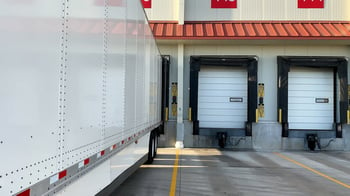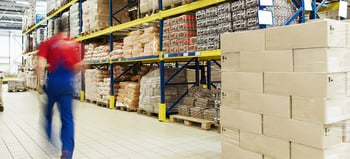
Few processes in order fulfillment are as labor- and time-intensive as your picking processes. Getting the right products off the shelves and ready for shipment quickly is an ongoing challenge for most warehouses and distribution centers.
Efficient order picking should be one of your priorities because this process typically accounts for more than half of warehouse operating costs. A better order picking process in your warehouse can help you save costs and deliver a better customer experience. Here are some order picking best practices to help you achieve these goals.
15 Order Picking Best Practices and Tips
Order picking involves the process of searching for and extracting products as well as any recordkeeping and paperwork activities. One of the most time-consuming parts of the process is traveling from one area of the warehouse to another, which isn’t the best use of time. So, how can your warehouse improve these processes? Here are some order picking best practices.
1. Choose the Best Warehouse Organization
 Organize your warehouse so that it makes the most sense for your inventory and the space you have. For example, receiving should lead directly to storage areas, which should have pathways to packing and shipping. This eliminates the need to make unnecessary trips. Your warehouse should also include proper signage so order pickers can find locations quickly.
Organize your warehouse so that it makes the most sense for your inventory and the space you have. For example, receiving should lead directly to storage areas, which should have pathways to packing and shipping. This eliminates the need to make unnecessary trips. Your warehouse should also include proper signage so order pickers can find locations quickly.
2. Create a Strong Receiving Process
When items come into your warehouse, they should be given a cursory inspection before being put away. This can prevent damaged or wrong items from being stored on warehouse shelves, which will impact the picking process. The more time you spend in this area can make picking even more productive and error-free.
3. Use Dividers, Totes, and Bins
Whether you store items on racks or shelves, try to subdivide those spaces using plastic dividers, totes, and bins to make it easier for pickers to find the correct products. This is particularly useful when storing small items, which can get mistakenly combined or confused with each other.
4. Choose the Right Picking Strategy
Your warehouse can implement various picking strategies to boost productivity and efficiency. There are different options, and which one you choose may not be the one that works (or doesn’t work) for someone else. Some of the primary order picking strategies include zone picking, batch picking, and wave picking.
5. Reduce Employee Travel Time
 It’s commonly knowns that travel time makes up a majority of the order fulfillment time (up to 50%). This partially depends on things like your warehouse layout, staff, and technology solutions. One of your objectives should be to reduce this travel time to improve efficiency, reduce errors and costs, and boost the customer experience.
It’s commonly knowns that travel time makes up a majority of the order fulfillment time (up to 50%). This partially depends on things like your warehouse layout, staff, and technology solutions. One of your objectives should be to reduce this travel time to improve efficiency, reduce errors and costs, and boost the customer experience.
6. Improve Picking Ergonomics
No matter which picking strategy you choose for order fulfillment, there will always be ergonomic risks. Your business can improve conditions for employees and achieve gains in efficiency by focusing on ergonomics. Examples include the use of lift tables and mobile workstations to make picking tasks easier and safer.
7. Store SKUs Together
Mixing SKUs in a single location can significantly impact your picking accuracy and productivity. If workers have to dig through a bin to find the right color or size of an item, your warehouse is likely going to experience mistakes and delays. Instead, make sure you only store single SKUs together.
8. Implement RFID Tracking
Visibility is essential for efficient warehouse operations and order fulfillment. The best way to inject visibility into your processes is by using RFID tags and a warehouse management system (WMS). Through RFID, you can gain real-time visibility into product data, such as location, descriptions, and quantities.
9. Use Light- and Voice-Directed Technology
 Your warehouse associates will be able to more quickly locate and pick the correct products using light- and voice-directed technology. Put-to-light and pick-to-light modules are mounted on a picking cart or wall. They use light to direct the picker to the right products. Voice systems are blue-tooth headsets that give commands to the worker, directing them to products for picking.
Your warehouse associates will be able to more quickly locate and pick the correct products using light- and voice-directed technology. Put-to-light and pick-to-light modules are mounted on a picking cart or wall. They use light to direct the picker to the right products. Voice systems are blue-tooth headsets that give commands to the worker, directing them to products for picking.
10. Create Zones and Consolidation Area
When using zoned picking, where items for multiple orders are picked at the same time, there should be a consolidation area to keep those orders separate. Having a mobile workstation that moves around the warehouse can be a significant benefit as workers move from one zone and consolidation area to the next.
11. Locate High-Volume Items Strategically
Using data collected from SKUs or RFID tags and the WMS, your warehouse can determine which items are moving in and out of the facility at the highest and lowest volumes. The frequently picked items should be located as close to packing and shipping areas as possible to reduce necessary travel.
12. Replenish Inventory Timely
The last thing you want in your warehouse is to have stockouts or end up storing too much of low-volume products. Your insights can also help you optimize your inventory levels and ordering strategy. Having sufficient inventory on hand will prevent workers from having to search for out-of-stock items, which is wasted time.
13. Consider Automated Picking Solutions
 Many warehouse managers believe that automation means robots will take over all of their processes. This would be costly and impractical. Most of today’s automation solutions are tools that work alongside employees, like cobots. These collaborative robots are flexible solutions that can pick products out of bins based on instructions to help workers be more productive.
Many warehouse managers believe that automation means robots will take over all of their processes. This would be costly and impractical. Most of today’s automation solutions are tools that work alongside employees, like cobots. These collaborative robots are flexible solutions that can pick products out of bins based on instructions to help workers be more productive.
14. Establish PIcking KPIs
It’s difficult to optimize your picking processes if you don’t know where you stand. Key performance indicators (KPIs) allow you to establish benchmarks for performance in your inventory management, picking, and packing processes. These insights will help you see what you’re doing right and identify areas requiring improvement.
15. Set Up a Returns Management Process
Depending on your industry, you can expect that as many as one-third of all orders will be returned by customers. Customers return products due to fulfillment errors, product damage, recalls, or other reasons. How you handle these returns, known as the reverse logistics process, will impact your bottom line. Make sure you set up a separate process for reviewing, restocking, recycling, and reselling these products to capture the most value from them and improve the customer experience.
Picking is a vital part of the order fulfillment process and is largely responsible for your warehouse’s efficiency and productivity. It’s essential that warehouse managers gain awareness of their different picking options and the technology solutions available to deliver accuracy and cost savings to these processes.












